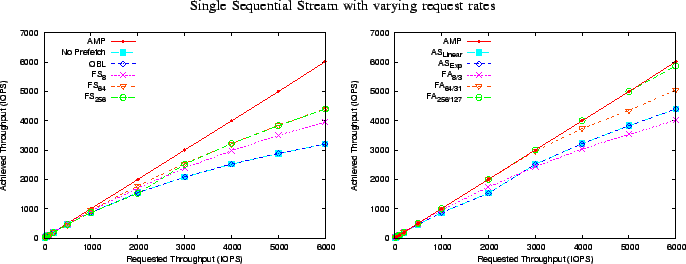 |

 |
As expected, we observe the lowest throughput for no prefetch.
The One Block Lookahead (OBL) algorithm performs about the same because we prefetch
only one page and the request size is ![]() pages.
A two or more block lookahead algorithm would have worked better by reducing
the amount of misses. This is precisely the intent of the Fixed Synchronous (FS) class of algorithms
which have a fixed degree of prefetch (
pages.
A two or more block lookahead algorithm would have worked better by reducing
the amount of misses. This is precisely the intent of the Fixed Synchronous (FS) class of algorithms
which have a fixed degree of prefetch (![]() ).
).
FA algorithms are superior to the FS algorithms because they
can start a prefetch on a hit thereby avoiding more misses than the FS
algorithms.
Both the FS and FA algorithm results seem to indicate that
the larger the ![]() , the better the performance. This is
true for a single sequential stream where the cache is abundantly available.
In multiple stream experiments which compete for cache space, we will better
appreciate the need for a careful choice of
, the better the performance. This is
true for a single sequential stream where the cache is abundantly available.
In multiple stream experiments which compete for cache space, we will better
appreciate the need for a careful choice of ![]() .
.
We also measure the performance of the adaptive synchronous
algorithms. AS
![]() and AS
and AS
![]() increase
increase
![]() as the detected sequence becomes longer. For all the adaptive algorithms in this
paper we uniformly use a maximum degree of prefetch of
as the detected sequence becomes longer. For all the adaptive algorithms in this
paper we uniformly use a maximum degree of prefetch of ![]() for a fair comparison.
Both AS variants perform roughly the same as they adapt and reach
this maximum value of
for a fair comparison.
Both AS variants perform roughly the same as they adapt and reach
this maximum value of ![]() during the first few seconds on the experiment.
during the first few seconds on the experiment.
AMP being able to adapt not only ![]() but also
but also ![]() convincingly outperforms the
FA algorithms by
convincingly outperforms the
FA algorithms by ![]() -
-![]() %, the AS algorithms by
%, the AS algorithms by ![]() %,
the FS algorithms by
%,
the FS algorithms by ![]() -
-![]() % and no prefetching and OBL by
% and no prefetching and OBL by ![]() %.
AMP closely followed by FA
%.
AMP closely followed by FA
![]() was able to satisfy the request rate
throughout the single stream experiment.
was able to satisfy the request rate
throughout the single stream experiment.